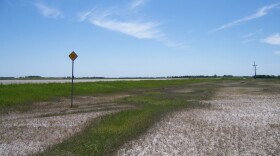We have had our fair share of cold weather this winter, with temperatures well into the twenty to thirty below zero range. Although many among us are more than ready for warmer temperatures, we also seem to fall back on that old saying that the cold temperatures “keep the riffraff away.” Those cold temperatures might also be helping keep the emerald ash borer away.
Much as Dutch elm disease decimated elm trees, the emerald ash borer could do something similar to our ash trees. And if green ash is not the most abundant and widely distributed tree in North Dakota it is close to it. It does well in our region, and as a result it has been widely planted in parks, boulevards, yards, farmsteads, and shelterbelts.
The emerald ash borer is an insect that is not native to the United States. It was first documented in Michigan in 2002 and has been spreading since. To my knowledge it has not been documented here in North Dakota yet, but it is getting closer. It is as close as Winnipeg, Manitoba. The closest documentation in Minnesota is in Stearns County (St. Cloud county seat). And it has also been documented in Minnehaha and Lincoln counties in South Dakota (Sioux Falls and Canton as county seats respectively). The question is not if the emerald ash borer will get here, it is a question of when.
But back to that cold weather. Winter’s cold weather is one of the factors that has helped slow the spread of the emerald ash borer into colder regions. It has been estimated that temperatures of 20 below zero may kill about half of them. Temperatures of 30 below could kill up to 90 percent of them. So perhaps we should look on the brighter side of these cold spells. They are helping save out ash trees!
We can also help slow the spread of this destructive pest. Don’t move ash firewood around. The larvae can be hiding in the bark. Also make a point of monitoring the health of ash trees. One of the more conspicuous indications of an infection is woodpecker damage of the bark on the trunk of the tree, particularly on the south side. Upon closer examination small “D” shaped holes in the bark where the adults emerge in the spring are ominous signs.
For more information on the emerald ash borer, or if you suspect an ash is infected, you might consider contacting your city forester, local NDSU Extension Service, North Dakota Department of Agriculture, or North Dakota Forest Service.
For more information on Emerald Ash Borer:




